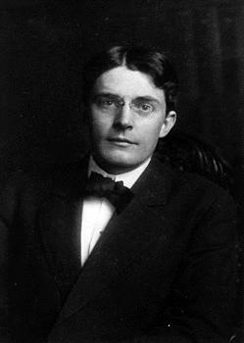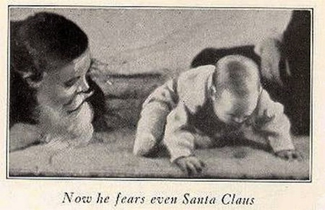| << Chapter < Page | Chapter >> Page > |

Watson’s ideas were influenced by Pavlov’s work. According to Watson, human behavior, just like animal behavior, is primarily the result of conditioned responses. Whereas Pavlov’s work with dogs involved the conditioning of reflexes, Watson believed the same principles could be extended to the conditioning of human emotions (Watson, 1919). Thus began Watson’s work with his graduate student Rosalie Rayner and a baby called Little Albert. Through their experiments with Little Albert, Watson and Rayner (1920) demonstrated how fears can be conditioned.
In 1920, Watson was the chair of the psychology department at Johns Hopkins University. Through his position at the university he came to meet Little Albert’s mother, Arvilla Merritte, who worked at a campus hospital (DeAngelis, 2010). Watson offered her a dollar to allow her son to be the subject of his experiments in classical conditioning. Through these experiments, Little Albert was exposed to and conditioned to fear certain things. Initially he was presented with various neutral stimuli, including a rabbit, a dog, a monkey, masks, cotton wool, and a white rat. He was not afraid of any of these things. Then Watson, with the help of Rayner, conditioned Little Albert to associate these stimuli with an emotion—fear. For example, Watson handed Little Albert the white rat, and Little Albert enjoyed playing with it. Then Watson made a loud sound, by striking a hammer against a metal bar hanging behind Little Albert’s head, each time Little Albert touched the rat. Little Albert was frightened by the sound—demonstrating a reflexive fear of sudden loud noises—and began to cry. Watson repeatedly paired the loud sound with the white rat. Soon Little Albert became frightened by the white rat alone. In this case, what are the UCS, CS, UCR, and CR? Days later, Little Albert demonstrated stimulus generalization—he became afraid of other furry things: a rabbit, a furry coat, and even a Santa Claus mask ( [link] ). Watson had succeeded in conditioning a fear response in Little Albert, thus demonstrating that emotions could become conditioned responses. It had been Watson’s intention to produce a phobia—a persistent, excessive fear of a specific object or situation— through conditioning alone, thus countering Freud’s view that phobias are caused by deep, hidden conflicts in the mind. However, there is no evidence that Little Albert experienced phobias in later years. Little Albert’s mother moved away, ending the experiment, and Little Albert himself died a few years later of unrelated causes. While Watson’s research provided new insight into conditioning, it would be considered unethical by today’s standards.

View scenes from John Watson’s experiment in which Little Albert was conditioned to respond in fear to furry objects.
As you watch the video, look closely at Little Albert’s reactions and the manner in which Watson and Rayner present the stimuli before and after conditioning. Based on what you see, would you come to the same conclusions as the researchers?
Advertising executives are pros at applying the principles of associative learning. Think about the car commercials you have seen on television. Many of them feature an attractive model. By associating the model with the car being advertised, you come to see the car as being desirable (Cialdini, 2008). You may be asking yourself, does this advertising technique actually work? According to Cialdini (2008), men who viewed a car commercial that included an attractive model later rated the car as being faster, more appealing, and better designed than did men who viewed an advertisement for the same car minus the model.
Have you ever noticed how quickly advertisers cancel contracts with a famous athlete following a scandal? As far as the advertiser is concerned, that athlete is no longer associated with positive feelings; therefore, the athlete cannot be used as an unconditioned stimulus to condition the public to associate positive feelings (the unconditioned response) with their product (the conditioned stimulus).
Now that you are aware of how associative learning works, see if you can find examples of these types of advertisements on television, in magazines, or on the Internet.
Pavlov’s pioneering work with dogs contributed greatly to what we know about learning. His experiments explored the type of associative learning we now call classical conditioning. In classical conditioning, organisms learn to associate events that repeatedly happen together, and researchers study how a reflexive response to a stimulus can be mapped to a different stimulus—by training an association between the two stimuli. Pavlov’s experiments show how stimulus-response bonds are formed. Watson, the founder of behaviorism, was greatly influenced by Pavlov’s work. He tested humans by conditioning fear in an infant known as Little Albert. His findings suggest that classical conditioning can explain how some fears develop.
Can you think of an example in your life of how classical conditioning has produced a positive emotional response, such as happiness or excitement? How about a negative emotional response, such as fear, anxiety, or anger?

Notification Switch
Would you like to follow the 'Psychology' conversation and receive update notifications?